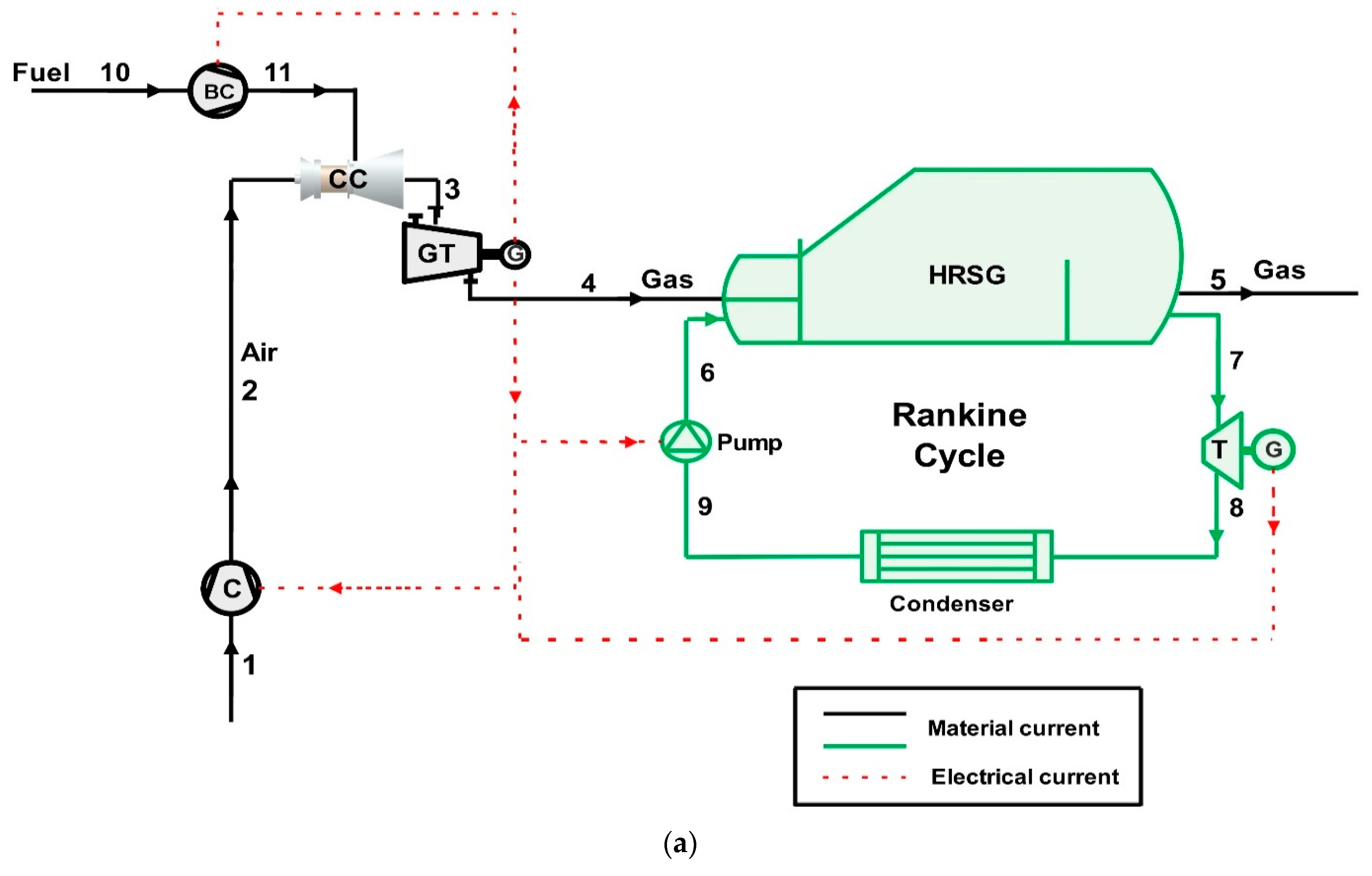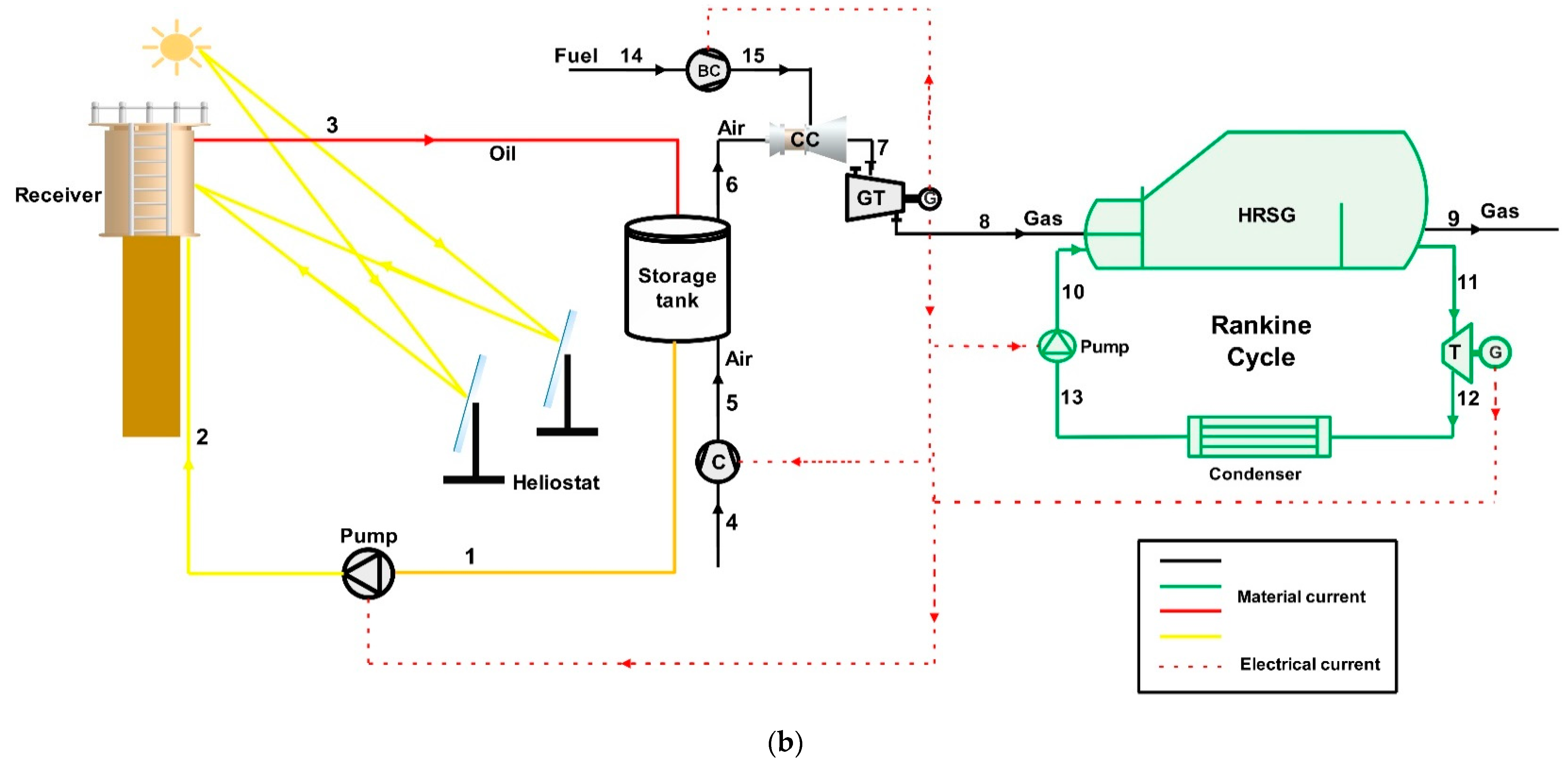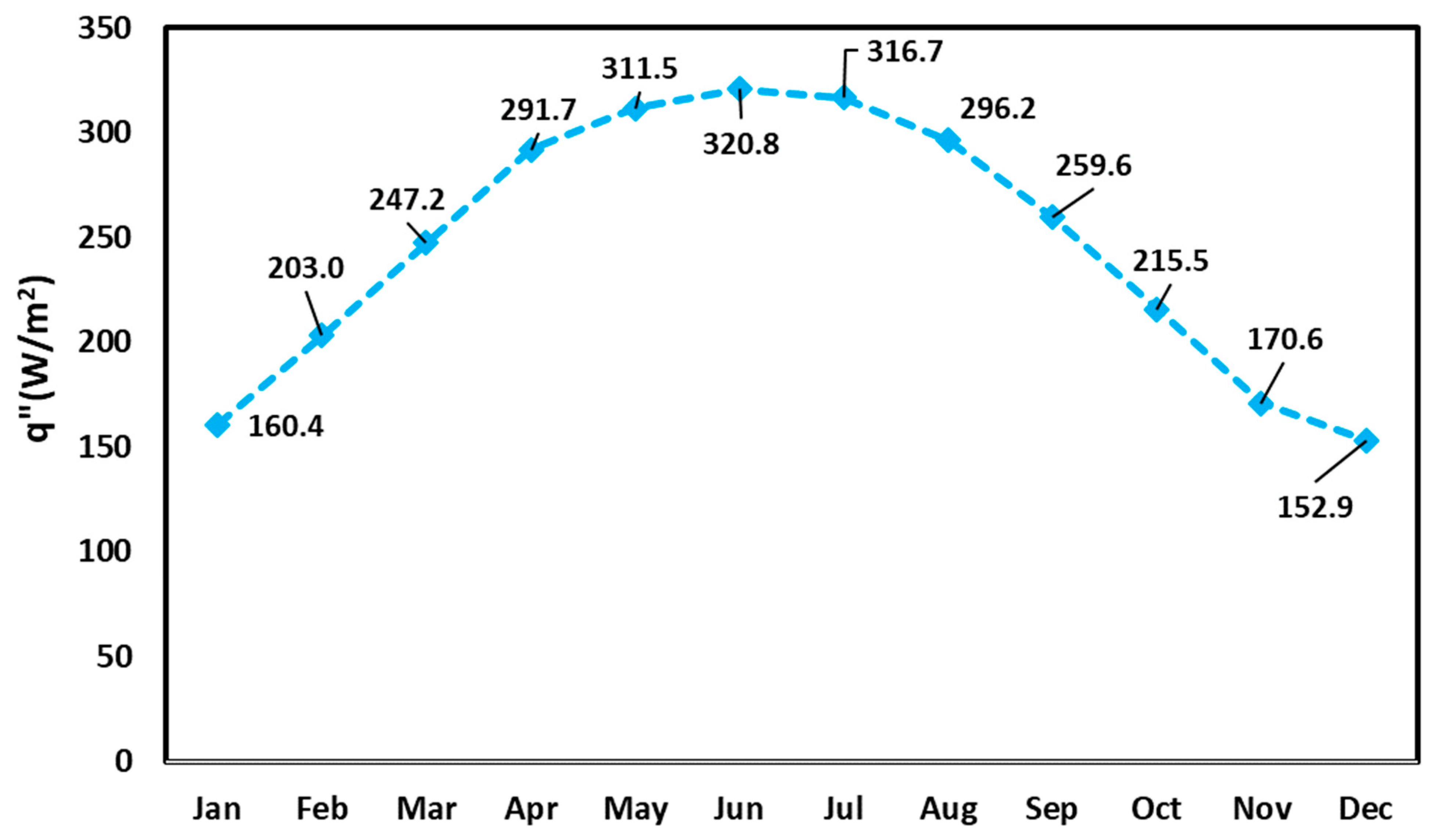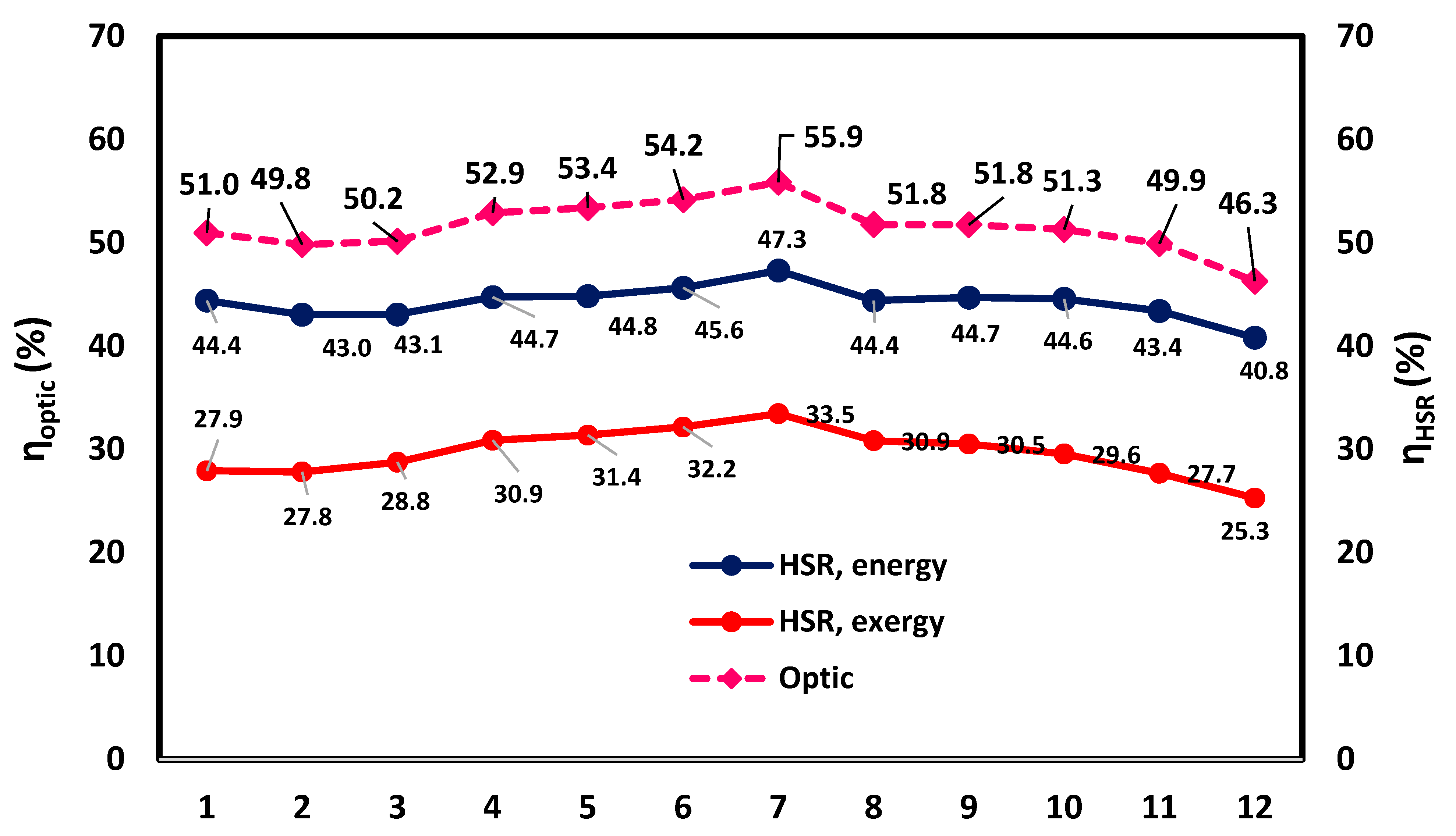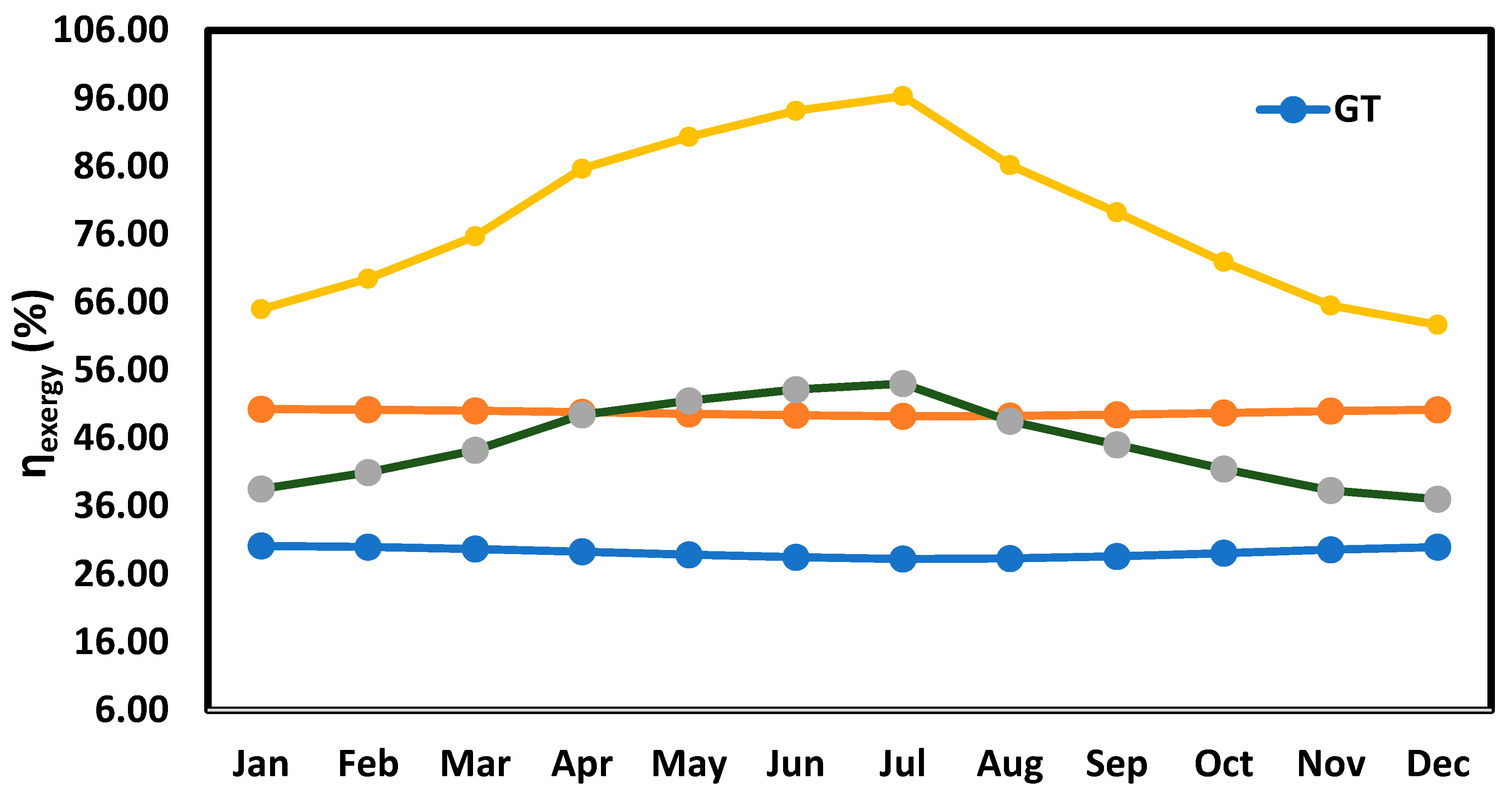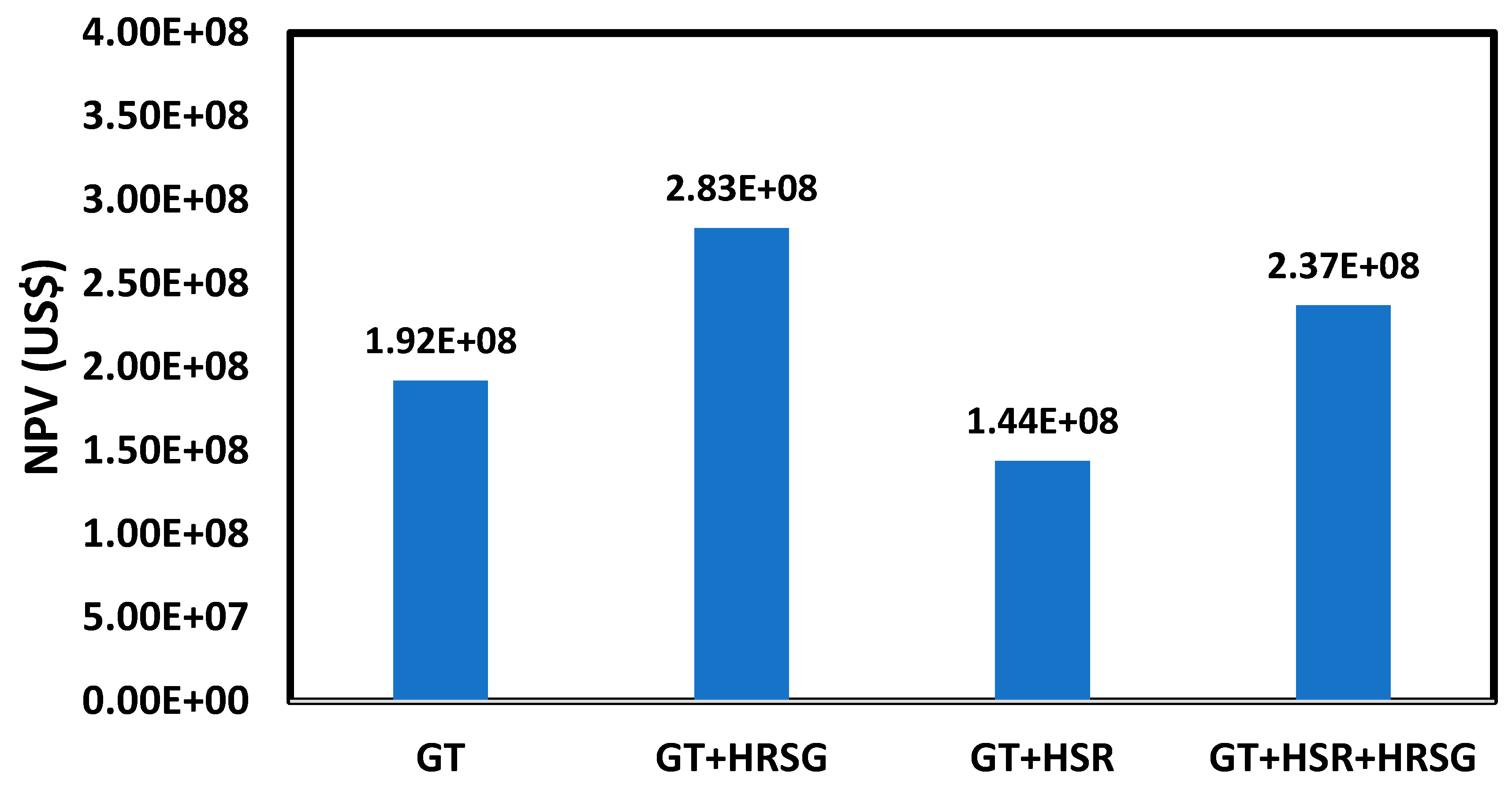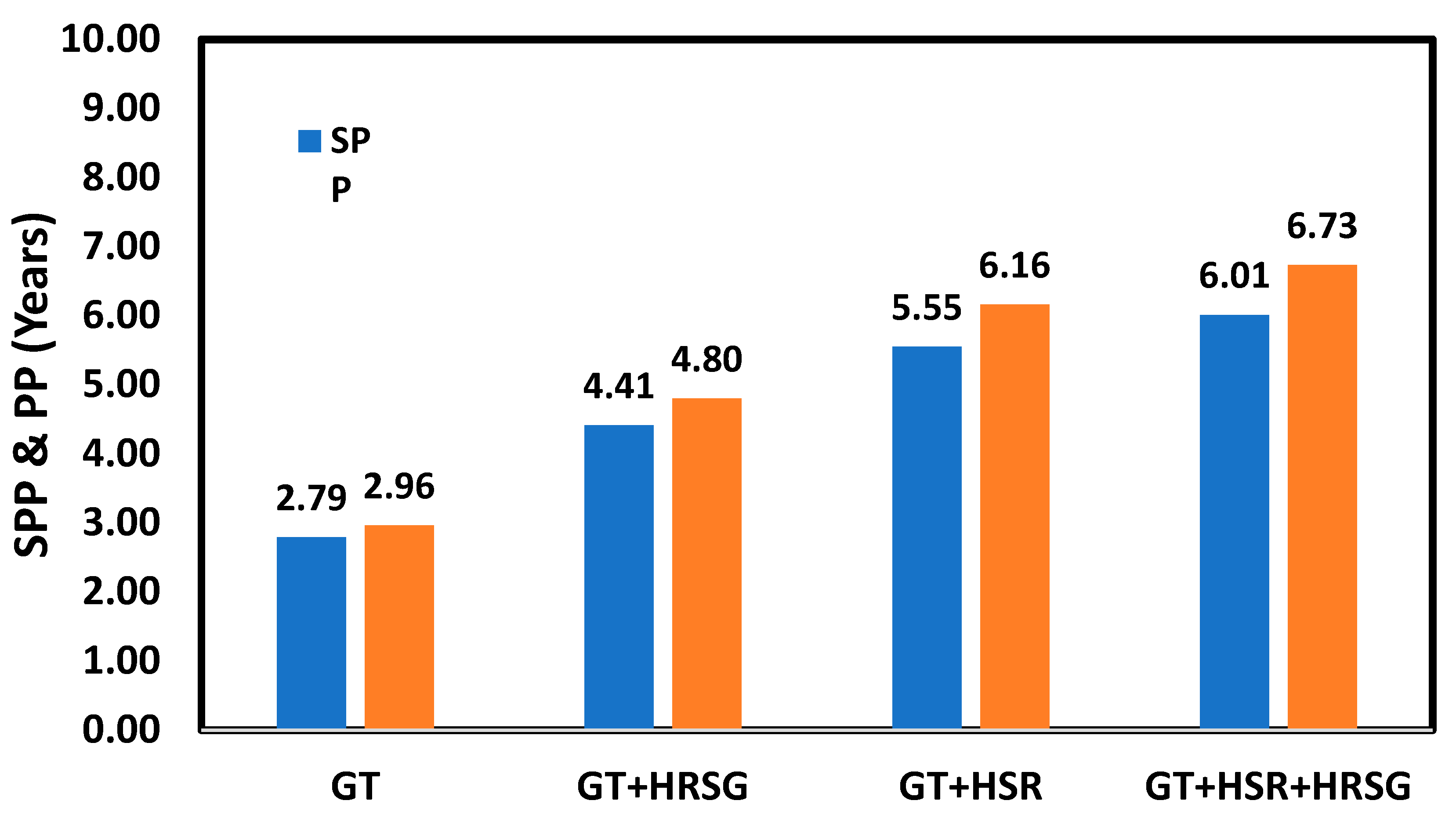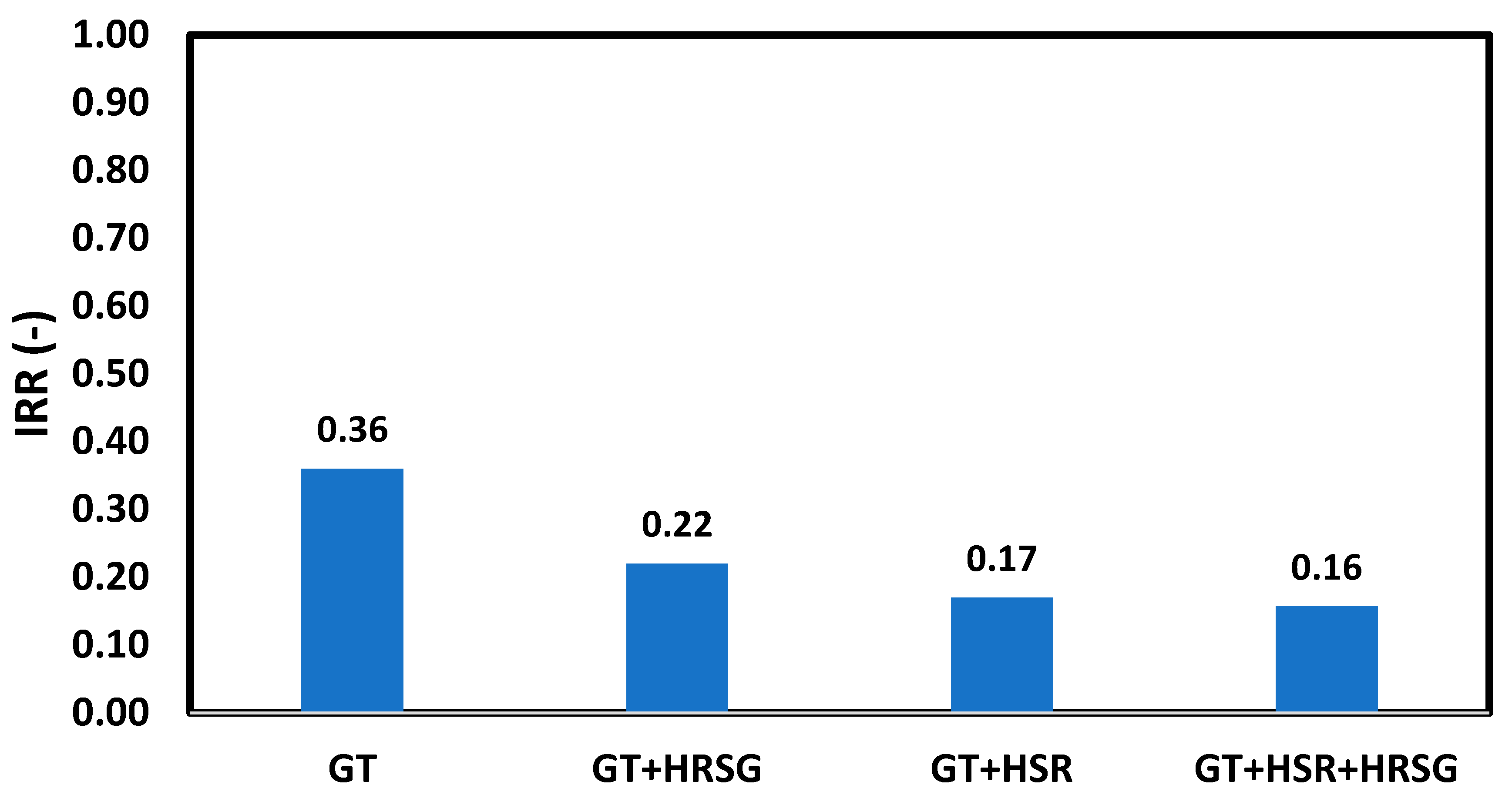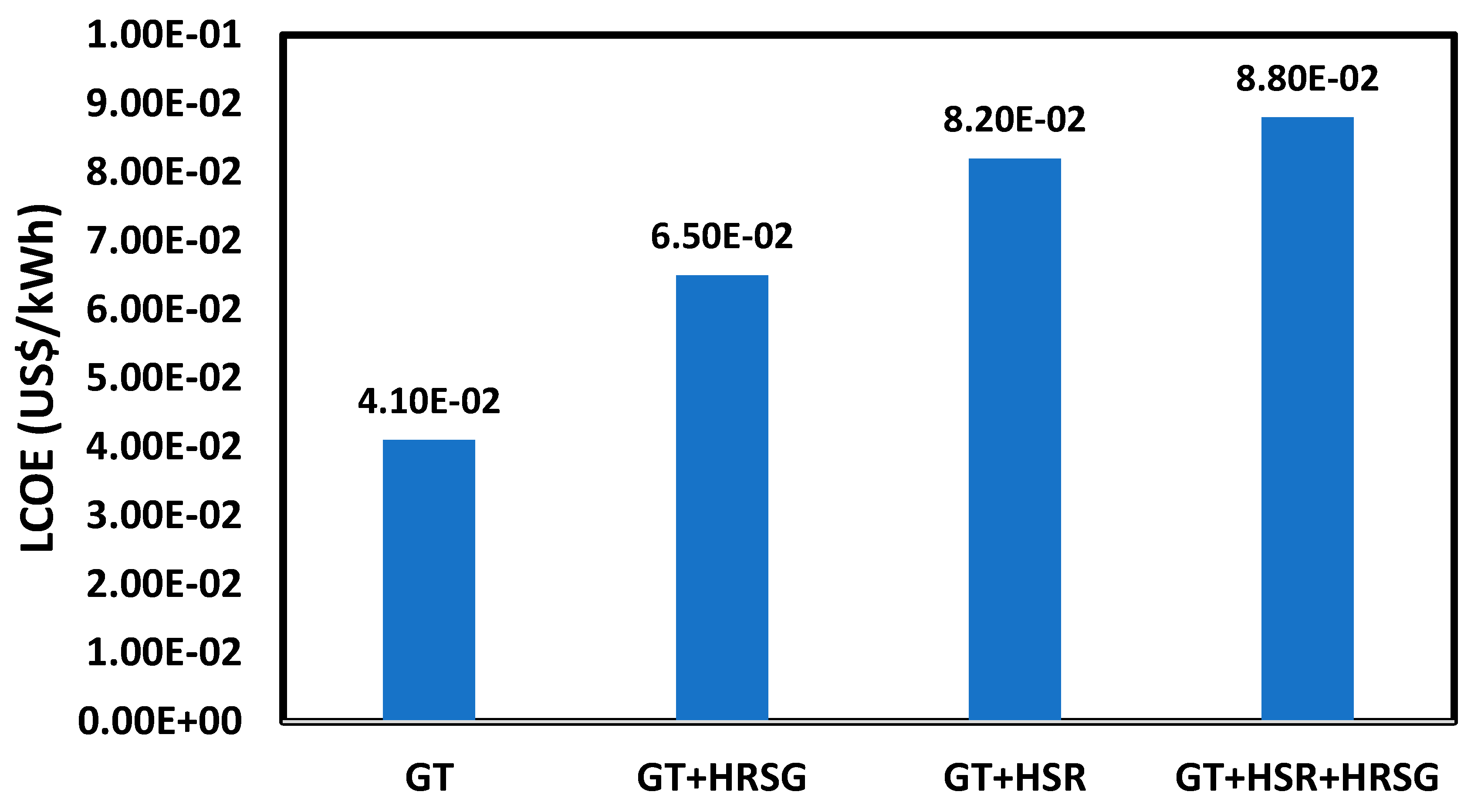2.2. Mass and Energy Balances
Regarding the modeling of these configurations, the following assumptions were considered:
The temperature of the environment was assumed to be 15 , and the pressure was 101.3 kPa.
The pressure loss and heat loss were respectively considered to be 3 and 5%.
In compressors and turbines, the thermodynamic process was polytropic.
Potential energy and kinetic energy were negligible.
According to the market, the efficiency of the combustion chamber was 92%.
The terminal pressure loss was presumed to be 3% through the pipe
Heat loss of components was assumed around 3% of the energy released by the hottest steam at these components.
According to the market, the efficiencies of the RC turbine and pump were considered to be 85%.
According to the market, the energy efficiencies of the condenser and evaporator were considered to be 85%.
According to the market, the efficiencies of the gas turbine, compressor, and booster compressor were 88%, 87%, and 87%, respectively.
For each component of both systems, energy and mass conservation laws were applied, which are presented as follows [
30]:
Here and h represent mass flow rate and specific enthalpy. and are heat and work transfer rate. V, g, and Z are velocity, gravitational acceleration, and height.
For the combustion chamber of the system (a), GT-HRSG, the following equation can be expressed:
In which, LHV denotes the low heating value of natural gas, for which the molar compositions can be found in
Table 1. Other symbols and subscripts are mentioned earlier.
Using
Table 1, the calculations that occur in the combustion chamber can be obtained as follows:
In Equation (4),
denotes the air to fuel ratio, and
and
are a mole and mass fraction of
i. The mass and energy balance equations for components of the GT-HRSG combined system are listed in
Table 2.
In
Table 2,
is efficiency, and subscripts T, GT, comp, BC, cond, and p respectively define the turbine, the gas turbine, the compressor, the booster compressor, the condenser, and the pump. For GC stand-alone, the net electricity production can be obtained as follows:
In which, subscript GT is the gas turbine, and
and
define the power requirement of the compressor and the booster compressor. For the combined cycle, the net power production is achieved as follows:
For system (b), GT-HRSG-HSR, the energy, and mass balance equations of the gas and Rankine cycles are similar to
Table 2 presented for the GT-HRSG system except for the change in streams’ number. The mass and energy balances for the HSR system are presented in
Table 3.
First and foremost, for solar radiation modeling, solar time can be achieved from the following equation [
36]:
In which,
and
are respectively local zone time standard meridian, and location longitude. Moreover, the parameter E from equation above is given as [
36]:
Here, n is equal to 1 on the first of January.
Sunset hour angle is another key parameter that can be formulated as follows [
36]:
Here,
and
denote latitude and deflection angles, respectively. The deflection angle is calculated using the following equation [
37]:
In which, n is equal to 1 on the first of January.
The solar direct beam irradiation can be obtained as follows [
37]:
Here, A and B are constants that can be found in Reference [
37], and
represents a solar zenith angle. Detailed information can be found in Reference [
37,
38].
For the heliostat field solar receiver, the following equation is formulated for calculation of total heat absorbed by the solar receiver [
39]:
In which,
is of total heat rate absorbed by the solar receiver,
and
are the solar energy input rate, and losses rate. The equation regarding heat loss rate can be expressed as [
39]:
Here, and are thermal energy losses associated with radiation and convection.
For the radiation form of thermal power losses, the following equation can be applied [
39]:
In Equation (15), and denotes the temperature of the receiver and the ambient environment. and denote the area of the receiver and surface emissivity of the receiver. represent the Stefan Boltzmann constant. The subscript redefines the receiver.
Additionally, the convection form of the thermal power losses is given as [
39]:
Here,
denotes the forced heat transfer coefficient of convection. Further information can be found in Reference [
39].
For the solar energy radiation absorbed by an HSR in Equation (13), the following equation can be used [
40]:
Here, denotes the solar receiver absorption factor, and is the optic efficiency of the heliostat. defines the total area of the aperture. Additionally represents the solar direct beam irradiation presented in Equation (12).
The optic efficiency of heliostat (
) can be formulated as follows [
41]:
Here,
denotes the efficiency of the mirror reflectivity rate that is assumed to be 95% in this study [
41].
is the efficiency of shadowing and blocking,
represents the efficiency of atmospheric attenuation,
defines the efficiency of spillage, and
is the cosine efficiency.
The shadowing and blocking efficiency, the blocking defines as a heliostat blocks a heliostat in the backside. Additionally, the shadowing occurs as a heliostat casts the shadow on an adjacent heliostat. In this study, the shadowing and blocking efficiency was assumed to be 95% [
42].
The atmospheric attenuation efficiency depends on two parameters, weather conditions and distance of heliostat and the receiver. For a distance more than 1000 m following equation can be expressed [
41]:
Additionally, for a distance lower than 1000 m the atmospheric attenuation efficiency is given as [
41]:
In which d is the distance mentioned.
The cosine efficiency can be calculated using the following equation [
43]:
In which,
represents the solar altitude angle [
44],
denotes angle between reflected irradiations and vertical direction [
43],
and
are respectively the solar azimuth angle, and the angle of the surface [
45]. For further information Reference [
46,
47] can be used.
Additionally, the spillage efficiency defines the failure of receiving reflected radiation of the heliostat field by the receiver is given as [
48]:
In which,
denotes the aperture effective size of the receiver,
is a parameter adapted from Reference [
48]. Further information about the calculation of
can be found in Reference [
48]. Therefore, using the above-mentioned equations, the solar energy input in Equation (17) can be achieved.
The heliostat energy efficiency is calculated by the following equation:
The working fluid employed in the cycle of the heliostat field solar receiver is Therminol-VP1, which its properties are presented in
Table 4 [
49].
The energy efficiencies of GT and combined cycle were calculated as follows:
The above-mentioned equations can be considered in whether to use an HSR cycle or not. The solar radiation was considered in the analysis. The following equation can be proposed for the energy efficiency of the GT-HRSG-HSR system:
In this equation, the nominator is the output power of a combined cycle and the dominator is the energy input rate of fuel gas and solar radiation.
2.3. Exergy Balances
Exergy analysis as a potent tool provides information about inefficiencies in a system that can lead to performance enhancement. Generally, exergy includes four parts; physical, chemical, potential, and kinetic. Specific exergy can be formulated as follows [
50]:
Here, h, T, and s are specific enthalpy, temperature, and specific entropy.
and
are mass and molar fraction.
defines the chemical exergy, and
denotes the gas constant. Subscript 0 refers to ambient conditions. Other parameters are described earlier. As mentioned, the potential and kinetic exergies were ignored in this study, and only the physical and chemical exergy was considered. The equations of exergy balance and exergy destruction rate for the GT-HRSG integrated system’s components are listed in
Table 5.
In
Table 6, symbols and subscripts are similar to
Table 5, which was earlier presented. Similar to the exergy balance of the GT-HRSG combined cycle, for Rankine and gas cycles of system (b), GT-HRSG-HSR exergy efficiency equations and exergy destruction rates can be formulated. For the HSR cycle,
Table 6 can be used for exergy efficiency and exergy destruction rate equations.
In
Table 7,
defines the exergy rate of solar energy input given as follows [
30,
51,
52]:
In which the and are the temperature of the environment and the sun.
The exergy efficiencies of GT and the combined cycle can be expressed as follows:
The above-mentioned equations can be considered in whether to use the HSR cycle or not. The solar radiation was considered in the analysis. The following equation can be proposed for energy efficiency of the GT-HRSG-HSR system:
2.4. Economic Analysis
An economic analysis can be employed to provide the economic performance of a system. To evaluate the economic profitability of two systems, capital investment costs and installation costs were obtained.
The total cost of the one system was calculated by the following equation [
53]:
In which, the subscripts installation, initial, OM, if, cont, dec, and lab denote installation, initial, operation and maintenance, indirect factor, unexpected technological and regulatory issues, decommissioning at the end of the project lifetime, and labor cost. The cost associated with installation cost was about 20% of the initial cost. Operation and maintenance costs were about 4% of the initial cost. The indirect factor, unexpected technological and regulatory issues, and decommissioning at the end of project lifetime were assumed to be 5%, 10%, and 5% of the initial cost of the system [
49,
54].
The labor costs for the system is given as follows [
48]:
In which, , and respectively represent the salary of staff, numbers of staff, and project lifetime that is considered in 20 years. The number 1.5 was considered for extra unpredictable costs.
For an integrated system (a), GT-HRSG, following
Table 7 is presented for cost functions of installation and capital investment.
In
Table 7, P,
, and
denote pressure, power rate, and mass flow rate. Subscripts GT, comp, BC, T, and P respectively define the gas turbine, the compressor, the booster compressor, the turbine, and the pump. Moreover,
,
, and
are respectively the area of the land, heliostat, and receiver.
defines the number of heliostats.
defines the number of the heliostat in cell
i, as the field is divided into 100 cells [
62].
denotes the heliostat density in
, which is the area of cell
i.
represents the distance of the cell’s center and the receiver. Further information can be obtained from Reference [
47,
57,
62,
63,
64]. E
TES is the amount of energy stored in the storage tank [
60]. Other subscripts int and outer define the interior and outer to express the diameter (D) of concentric piping. For more information, Reference [
23,
48,
59] can be used.
is calculated as follows [
48,
56]:
The simple payback period of a system (SPP) is given as [
40,
65]:
In which, Z defines the cash flow of a system per year.
For the cash flow of both systems per year following equation can be used [
40,
65]:
Here, the
denotes the specific cost of electricity produced by the systems that is considered equal to 0.22 U
$/kWh [
65,
66].
represents the annual electricity production capacity. It should be mentioned that the price of natural gas in this study was 0.07 U
$/kWh [
67].
For both systems, the payback period (PP) equation can be written as [
40,
65]:
In which, the r is the factor of discount considered as 3% in this study [
40,
65]. The internal rate of return (IRR) for a system is given as [
40,
65]:
Here, N defines the lifetime of a system that is 20 years in this study. Additionally, the net present value (NPV) of a system can be formulated as follows [
40,
65]:
